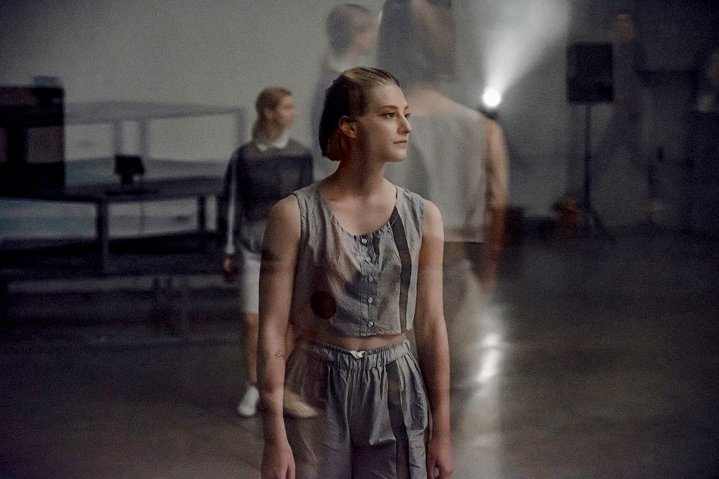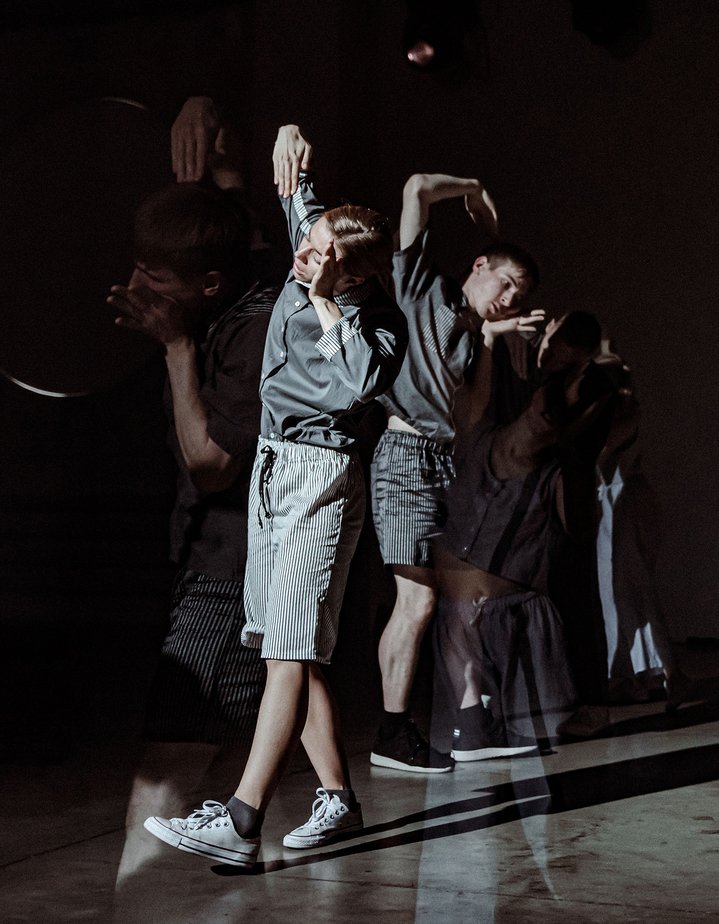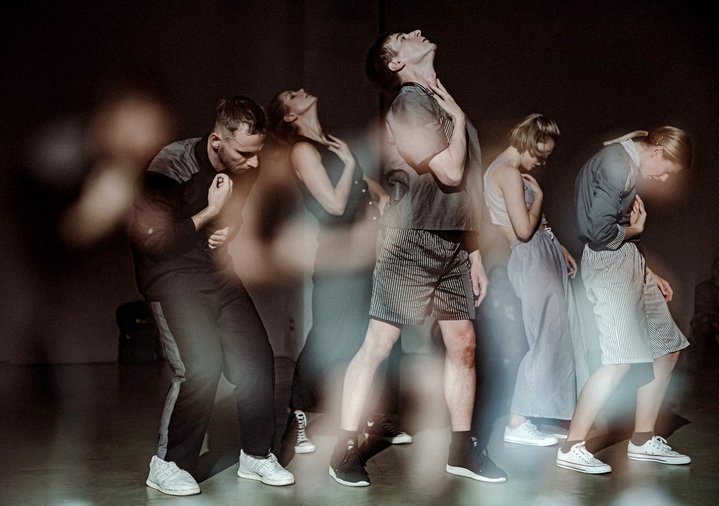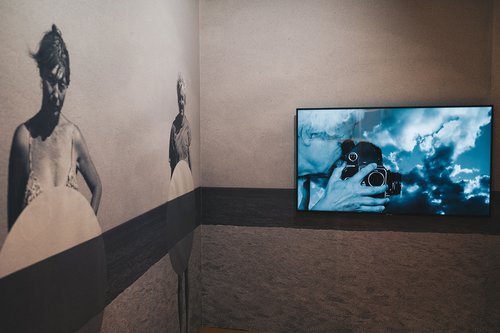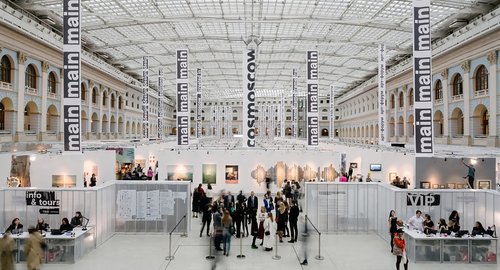Place of Action. Introduction, 2022. Performance by Alexei Narutto and Olga Timoshenko. Photo: Masha Hutortseva. Courtesy of Diana Vishneva Foundation × Cosmoscow
Dance and contemporary art performance: moved by painting
Three choreographers put on a live performance inspired by the paintings of Russian artist Valery Chtak, Cosmoscow’s Artist of the Year. The project was created by two institutions – Cosmoscow Foundation and Diana Vishneva Foundation.
The premiere of a live performance of ‘Place of Action’ and ‘The Container’ was based on two video pieces of the same names first shown at the 9th Cosmoscow Foundation's charity auction, where they had been presented as one lot jointly consigned by both the Diana Vishneva Foundation and a Russian contemporary choreography festival called Context. Both of these organisations today are working independently to support the development of contemporary art in Russia, looking to integrate it into the cultural space. Both are celebrating their tenth anniversaries in 2022.
Combining both contemporary art and dance, these works are based on paintings by Valery Chtak (b.1981). The two works, both independent yet connected, were created with the additional support of an art space in the city of Kostroma, called the Stantsia Art Venue, founded by the Dialogue Dance Company to foster contemporary art and house artist residencies. This year, on the eve of the tenth Cosmoscow Fair, these two video works with Chtak’s distinctive aesthetics took on a new form as performances staged live for the very first time.
The original video work was made by choreographers Olga Timoshenko and Alexei Narutto, winners of the young choreographers' competition launched by the 'Context. Diana Vishneva' Festival for contemporary dance and was further developed at Stantsia’s space in Kostroma, a former textile factory converted into a performance venue. The videos present a succession of different locations each one styled after paintings by Chtak: the walls are rendered in slap dash form, the ceilings are covered with tiles decorated in striking, primitive, naive patterns. Focussing on the patterns themselves, calls forth the suprematist art of Kazimir Malevich or the abstraction of Mark Rothko in which abstract forms have their own autonomy. Thus here two dancers step, jump, move slowly in circles, interrupting one another from time to time, unceremoniously breaking the immutability and monotony of the space, like the inscriptions in Chtak's paintings which slice through the laconicism of colour and form.
Yet the medium of live performance transformed these videos into something quite different, especially ‘Place of Action’, where a large crowd of spectators flooded into what had essentially been a kind of sealed hermetic world. All of a sudden, as if from nowhere, an attractive female computer voice broke the silence giving instructions to the audience to leave their phones on, make lots of videos and photos, occupy whatever space they want in the performance room (a kind of hanger with high ceilings) and move around when and where they want. People, put at ease by these friendly commands, really did disperse, filling up the whole space and oblivious to the appearance of five performers. The performers initially walked slowly mingling with the audience, then speeding up the pace of their movements they walked faster and faster until at different points in the hall they joined up with one another, and separated again creating fast paced solos, duets; they danced alone and in small groups. This all built up tension in the audience, the speed of the movement made the audience members themselves start to move around the space faster, trying to keep up with the dancers. In this way the audience also became part of the choreography.
At the same time, a language-based dimension was building up alongside the movement. Textual symbolism of course lies at the centre of Valery Chtak's art in which simple everyday conversational turns of phrase such as ‘Kind of similar’ or ’I knew you were going to say that’ are taken out of their usual context and acquire philosophical, ontological dimensions. These painted phrases imitating graffiti on canvas reflect the non-conformity of street art even if they do not belong to that tradition. Chtak's usual visual semantic and linguistic games were transformed into audio soundbites during the dance performance. You could hear phrases from the artist's paintings come from gadgets the performers were holding. As the performers moved around so did the gadgets and thus the sound got louder and losing its anchor. In the build up to the finale of the performance, the same soft attractive voice heard at the beginning began to chant louder and louder the phrase: ‘The future is forever’ repeating the phrase and title of one of Chtak's paintings. Towards the end, it turned into a hysterical, almost gutteral scream completely twisting the impact and meaning of the original statement.
This performance was followed in stark contrast by ‘The Container’. The anxiety unleashed in the movements of the audience and dancers was replaced by an almost pure, pared back, classical seating arrangement of the audience in chairs around the perimeter of the stage. The performers separated their own space from that of the audience using ropes and stancions, and they embarked on a dance which had a constant flow of expression, creating a meditative, almost soporific effect. The choreographer behind this performance was dancer, musician and poet Ilya Manylov, who built on the original video with a half hour ‘statement’ in dance. He took Chtak's paintings, somehow transforming them into a score of dancers' movements, although from the performance itself this was hard to follow. The five performers improvised throughout the piece, united by an uninterrupted flow of movement, yet at no point did they merge into a coherent whole. Each bore his/her own individual plastique and unique energy. The dance performance took place entirely within an enclosed, rectangular shape, a constant leitmotif in Chtak's art, and in this sense the ‘The Container’ echoed in rhyme with the artist's paintings.
Whereas ‘Place of Action’ revealed a dynamic episode of artistic protest in Valery Chtak's paintings, ‘The Container’, on the contrary, submerged the viewer in contemplation and passivity. The first performance unlocked the notion of the confined space of both painting, the stage and also our own human thinking, while the second revisited it. Both choreographic works explored the possibilities of interaction between contemporary dance and visual art and showed us that this exploration has no limits.








